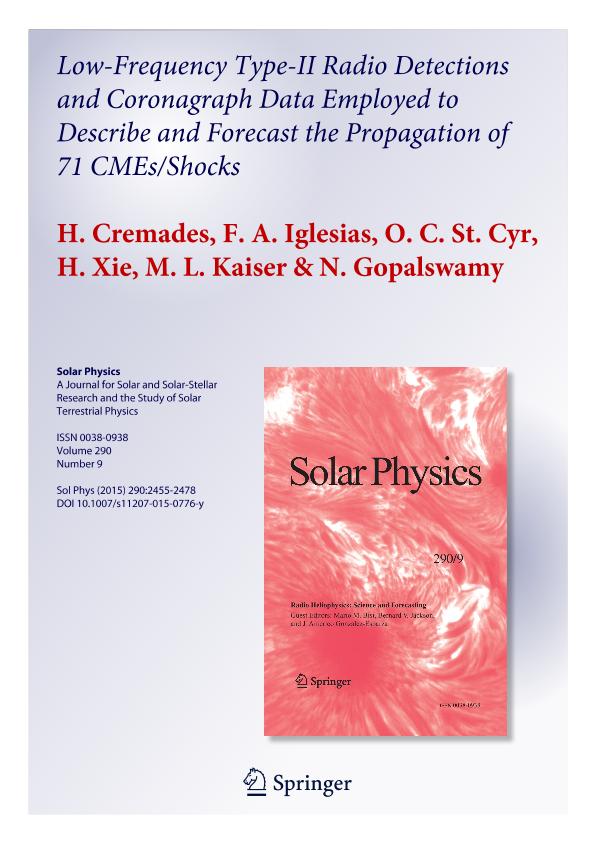Artículo
Low-Frequency Type-II Radio Detections and Coronagraph Data Employed to Describe and Forecast the Propagation of 71 CMEs/Shocks
Cremades Fernandez, Maria Hebe ; Iglesias, Francisco Andres
; Iglesias, Francisco Andres ; St. Cyr, O. C.; Xie, H.; Kaiser, M. L.; Gopalswamy, N.
; St. Cyr, O. C.; Xie, H.; Kaiser, M. L.; Gopalswamy, N.
 ; Iglesias, Francisco Andres
; Iglesias, Francisco Andres ; St. Cyr, O. C.; Xie, H.; Kaiser, M. L.; Gopalswamy, N.
; St. Cyr, O. C.; Xie, H.; Kaiser, M. L.; Gopalswamy, N.
Fecha de publicación:
10/2015
Editorial:
Springer
Revista:
Solar Physics
ISSN:
0038-0938
Idioma:
Inglés
Tipo de recurso:
Artículo publicado
Clasificación temática:
Resumen
Motivated by improving predictions of arrival times at Earth of shocks driven by coronal mass ejections (CMEs), we have analyzed 71 Earth-directed events in different stages of their propagation. The study is primarily based on approximated locations of interplanetary (IP) shocks derived from Type-II radio emissions detected by the Wind/WAVES experiment during 1997 – 2007. Distance–time diagrams resulting from the combination of white-light corona, IP Type-II radio, and in-situ data lead to the formulation of descriptive profiles of each CME’s journey toward Earth. Furthermore, two different methods for tracking and predicting the location of CME-driven IP shocks are presented. The linear method, solely based on Wind/WAVES data, arises after key modifications to a pre-existing technique that linearly projects the drifting low-frequency Type-II emissions to 1 AU. This upgraded method improves forecasts of shock-arrival times by almost 50 %. The second predictive method is proposed on the basis of information derived from the descriptive profiles and relies on a single CME height–time point and on low-frequency Type-II radio emissions to obtain an approximate value of the shock arrival time at Earth. In addition, we discuss results on CME–radio emission associations, characteristics of IP propagation, and the relative success of the forecasting methods.
Archivos asociados
Licencia
Identificadores
Colecciones
Articulos(CCT - MENDOZA)
Articulos de CTRO.CIENTIFICO TECNOL.CONICET - MENDOZA
Articulos de CTRO.CIENTIFICO TECNOL.CONICET - MENDOZA
Citación
Cremades Fernandez, Maria Hebe; Iglesias, Francisco Andres; St. Cyr, O. C.; Xie, H.; Kaiser, M. L.; et al.; Low-Frequency Type-II Radio Detections and Coronagraph Data Employed to Describe and Forecast the Propagation of 71 CMEs/Shocks; Springer; Solar Physics; 290; 9; 10-2015; 2455-2478
Compartir
Altmétricas



